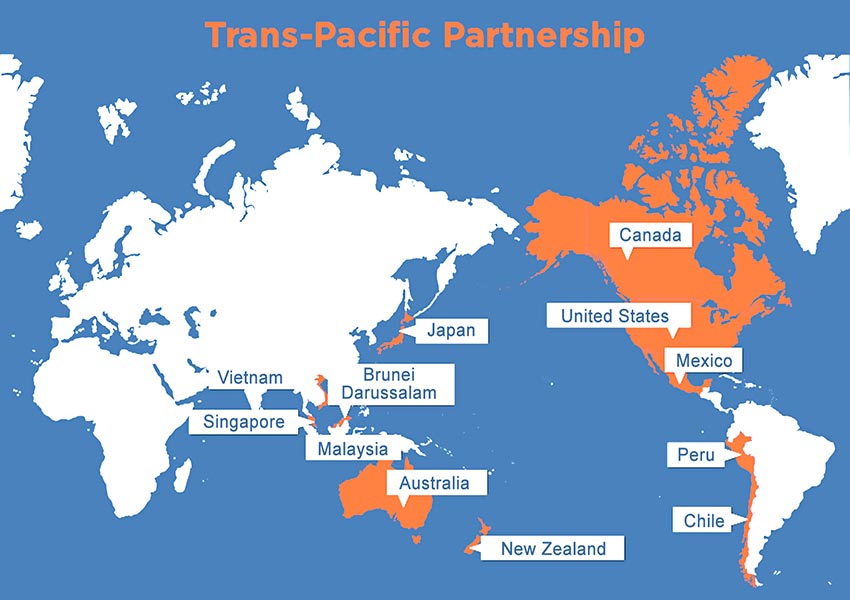On October 5th, twelve counties announced with great fanfare that the Trans-Pacific Partnership (TPP) treaty was finally agreed upon. The final hurdle fell as negotiators worked until 5 in the morning to change the patent period for new drugs from 12 to 7 years to appease Australia, Chile, and New Zealand who had complained that the agreement would drive up their medical costs.

The Trans-Pacific Partnership (TPP) is a proposed trade agreement among 12 Pacific Rim countries, including the U.S. and Japan, with the purported goals of lowering trade barriers and promoting investment.
Signatories to the treaty include Brunei, Chile, New Zealand, Singapore, Australia, Canada, Japan, Malaysia, Mexico, Peru, The United States, and Vietnam. Indonesia said it will join, too. China was invited but backed away because it did not want that restrictions placed on its financial sector and certain other businesses.
The text of the actual treaty is supposed to be kept secret so that member nations can present it to their respective parliaments without too much clamoring from those who would oppose it. The presumption is those who negotiated the treaty were working with the interests of their countrymen in mind. However, an unidentified individual leaked a chapter related to intellectual property to Wikileaks on October 9th. This is the third time over the past three years that drafts of the bill have been published by WikiLeaks.
Below I will give a summary of what the treaty says, based on a detailed summary written by the U.S. Office of the U.S. Trade Representative.
For those who oppose the TPP, much as been made of the secret nature in which the treaty was negotiated. U.S. Congressmen who wanted to read it had to leave their cell phones and aides behind. One web site makes fun of this secrecy. It purports to provide the full text of the agreement online. But when you try to click the button to read the text the cursor moves away from the button.
President Obama weighed in on the controversy. He said, “You’ve got some critics saying that any deal would be rushed through; it’s a secret deal, people don’t know what’s in it. This is not true. Any agreement that we finalize with the other 11 countries will have to be posted online for at least 60 days before I even sign it.”
Democrat presidential candidates generally oppose it while Republican ones are non-committal. Bernie Sanders came out against if. Donald Trump was characteristically blunt calling it “a disaster.” Hillary Clinton, who as Secretary of State called it “the gold standard,” supports it no more. Ben Carson said, “I think free trade is a wonderful thing, but I think it needs to be done the right way. Mike Huckabee says most people do not even understand it.
If you Google TPP, most of what comes up is negative, except Fortune magazine’s article, “Why the TPP is Good for Small Business” rise near the top of the list. That Fortune, whose allegiance is to business, supports it, while the majority of the other Google links do not, says a lot says a lot right there.
Of course, those that oppose the treaty want to make themselves heard; those that favor it would be wise not to gloat.
Americans who support financial reform are worried that the TPP would let banks overturn banking laws meant to reign them in. Others object to intellectual property provisions. The bill might hold ISPs responsible if their customers are downloading movies from The Pirate Bay.
As for drugs, India is not a party to the treaty but The New England Journal of Medicine says member nations follow India’s lead on generic drug policy. In India, a new formulation of an existing drug cannot be given patent protection. So when “The-Evil-Drug-Company” takes its 30-year old heart drug and changes it in some small way, India would not recognize their patent.
In an article entitled, “The Trans-Pacific Partnership-Is It Bad for Your Health?” that revered publication said, “Patents increase the annual cost of antiretroviral therapy from around $100 per person to $10,000 per person…. Indeed, some proposals in the leaked IP chapter seem directly targeted against innovative measures that developing countries have used to maximize the use of low-cost generic medicines.”
A summary of the 30 chapters in the treaty prepared by The U.S. Trade Office says that that agreement eliminates and reduces tariffs “…across substantially all trade in goods and services…” They say the treaty addresses the role of state-owned enterprises, the need for conservation, and the digital economy.
They say the agreement reduces and eliminates tariffs on industrial and agricultural goods. That includes an agreement to eliminate agricultural subsidies targeted toward supporting exports. But you could note that there is no discussion in the U.S. Congress about cutting off to corn, milk, and sugar cane growers at present. Given the history of that, that seems not likely to change.
Tariffs will be reduced immediately in most cases. Tariffs on textiles and apparel will be eliminated completely. The treaty addresses currency manipulation, which is a tool whereby a country can increase its exports by reducing the value of its currency. The treaty requires countries to help prevent smuggling and fraud and, oddly enough, since it purports to get rid of most of them, “duty evasion.” There are strict rules to determine the country of origin for manufactured goods so that non-member nations cannot game the system to enjoy tariff relief.
While the summary is vague in most cases, it does specifically say that countries cannot require that IT companies build data centers inside their borders in order to do business there. Presumably that means a country cannot compel tech firms to keep data on its citizens inside its borders, as Europe is demanding of Facebook and Google now.
There are provisions requiring countries to stop the illegal trafficking in wildlife, illegal fishing, illegal logging, and to protect the marine environment. Countries agree to enforce their environmental laws and not weaken them to encourage trade of investment. Member nations are required to create websites that explain the rules in an easy-to-understand manner so that small to medium enterprises can do business there without requiring a whole roomful of attorneys. Countries agree to adopt laws to make paying bribes to government officials to obtain business a crime. Given the nature of corruption is many of these countries, one wonders whether that would make any difference. Already European nations are allowed to deduct the cost of bribes on their tax returns while American companies are not.
The agreement does not appear to give any existing international tribunal, such as the WTO, jurisdiction over disputes arising from the law. Instead it says a commission of judges will be created to adjudicate such matters as they arise. It does say that each country’s courts must accept the litigant’s claim to jurisdiction. The TPP creates the Trans-Pacific Partnership Commission bureaucracy to oversee all of this.
If we look for a comment or some kind of informed opinion on the TPP, we can find something in the pages of The Guardian. That newspaper said Nike supports it because of its stance on textiles.
Take a moment and try to figure out why. If you look at the website of the U.S. Customs and Border Protection service, it is horribly complicated to figure out just what import duties Nike is forced to pay on shoes they make overseas. In order to calculate the import duties on, say, tennis shoes, you need to know whether the country is a member of APEC (Asia-Pacific Economic Cooperation), you need the HS Commodity code, and much more. The website Duty Calculator tries to make this calculation easier. But you can see the mindless complexity of that when you look for the tariff there. Their web page asks whether these are male or female shoes, are they make of plastic or rubber, and are they for sports or leisure. When you enter all that it shows duties for each country. The rates for each country are widely disparate. For Indonesia its 25%. For Vietnam it is 30%. For Japan, where they make origami shoes out of paper, it’s 10%. For those too impatient to read all of this, as if in a gesture of desperation. The page concludes that the “average import duty on Fabrics” exported to the USA is 17%.
It will take some time for the details of the treaty to be known and for different governments to sign it into law. So we have to wait to make further comment on that.


